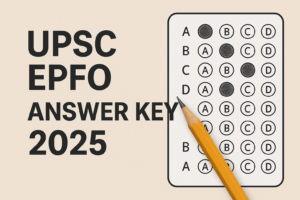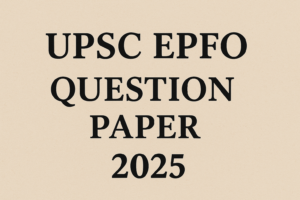Q8. How does smart city in India address the issues of urban poverty and distributive justice? (10 Marks, 150 Words)
| Approach |
| Introduce with current data by Lok Sabha on SCM. Mention a brief about the SCM. In the body, first address ways in which Smart cities are addressing issues of urban poverty and distributive justice. Secondly, throw light on the limits of smart cities in addressing the issues. For a problem solving approach provide a way forward. Conclude with the commitment towards Panch Pran of Amrit Kaal: Road to 100 years of Independence. |
The Smart City Mission was launched in 2015 to improve the quality of life in hundreds of cities by providing efficient services, robust infrastructure, and sustainable solutions. It also empowers people by enabling local area development, enhancing social equity and addressing issues of urban poverty and distributive justice.
How Smart cities are addressing issues of urban poverty
- Holistic poverty reduction: Convergence with welfare schemes of the government such as PM SVANidhi and National Urban livelihood mission (NULM) among other social security schemes to provide a multi-dimensional approach to poverty eradication.
- Eg: Varanasi Smart City integrates heritage-based tourism with street vendors zones
- Inclusive urban habitats: Promote housing for the Economically Weaker Sections (EWS) and Low-income groups through in-situ slum redevelopment and convergence with Pradhan Mantri Awas Yojana (PMAY-Urban)
- Eg: Slum redevelopment projects in Pune Smart city combine housing with basic amenities to enhance urban liveability.
- Ensuring standard of living: Emphasises universal access to safe drinking water, sanitation, energy, healthcare, and education under the principle of equity in urban provisioning.
- Eg: Indore Smart City has adopted an underground waste collection system and door-to-door solid waste management, improving hygiene and reducing health vulnerabilities in low-income settlements
- Employment generation: Create knowledge based and green jobs through IT-enabled services, e-governance, waste-to-energy projects and start-up incubation hubs.
- Eg: Pune Smart City set up a co-working start-up incubation space supporting small entrepreneurs from low-income groups.
How Smart cities are addressing issues of distributive justice
- Equitable allocation of urban resources: Reduce spatial inequalities by ensuring access to digital infrastructure, electricity across all socio-economic groups.
- Eg: Ahmedabad Smart City implemented IoT enabled water supply in slum areas to ensure universal service delivery.
- Skill development: Include skill enhancement centres, incubation hubs, and start-up ecosystems to improve employability of the urban poor.
- Eg: SCM addresses capability poverty as per Amartya Sen’s framework.
- Eg: Bhubaneswar Smart City has established Skill Development Centres under the “Bhubaneswar One” initiative
- Gender sensitive: Projects are designed with universal accessibility, women-friendly public spaces, and safety surveillance to protect vulnerable groups to integrate gender-sensitive and inclusive urban design.
-
- Eg: Pune and Bhopal Smart Cities have introduced smart street lighting, panic buttons, and CCTV coverage to enhance safety for women and children in public spaces.
- Participatory urban planning: Digital platforms like Integrated Command and Control Centres (ICCCs) enable grievance redressal, service delivery, and participatory decision-making, promoting accountable urban governance.
Limitations of Smart cities in addressing issues of urban poverty and distributive justice
- Socio-economic exclusion: Smart city projects often prioritise high-tech infrastructure, leading to the marginalisation of low-income communities.
- Eg: In cities like Pune and Bhubaneswar, redevelopment projects have displaced slum dwellers due to lack of affordable housing integration.
- Digital divide: A significant portion of urban poor lacks digital literacy and access to ICT tools, preventing them from benefiting from e-governance and smart service delivery.
- Eg: Online grievance redressal and digital payment systems in Bhopal Smart City remain underutilised among migrant labourers due to limited smartphone usage.
- Limited participatory governance: Lack of inclusive decision-making excludes urban poor from planning processes, leading to policies that fail to address their needs.
- Eg: In Jaipur Smart City, planning meetings had limited representation from women’s self-help groups and street vendors.
- Environmental displacement: Urban redevelopment sometimes leads to the relocation of slum dwellers to peripheral areas, increasing their commuting costs and reducing access to basic services.
- Eg: Delhi’s smart city zones witnessed relocation of informal workers to distant resettlement colonies, exacerbating economic vulnerabilities.
Therefore, as we navigate towards the path of Amrit Kaal and India @2047 agenda, embracing and investing in resilient Smart cities is not just a strategic choice but a testament to our commitment to Panch Pran of Amrit Kaal as we walk the road to India @100 years of independence

 UPSC EPFO Answer Key 2025 Out (Unofficia...
UPSC EPFO Answer Key 2025 Out (Unofficia...
 UPSC EPFO Question Paper 2025 PDF Downlo...
UPSC EPFO Question Paper 2025 PDF Downlo...
 UPSC EPFO Admit Card 2025 Out @ upsc.gov...
UPSC EPFO Admit Card 2025 Out @ upsc.gov...

























